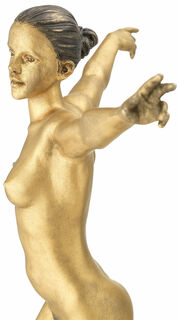Sculpture "Freedom" (2021), bronze on marble pedestal
Sculpture "Freedom" (2021), bronze on marble pedestal
Quick info
ars mundi Exclusive Edition | limited, 99 copies | numbered | signed | foundry stamp | certificate | bronze + marble | chiselled | polished | patinated | size total 49 x 27 x 19 cm (h/w/d) | weight approx. 6 kg
Video
Detailed description
Sculpture "Freedom" (2021), bronze on marble pedestal
Freedom is female. This not only refers to its grammatical gender but also to its traditional placement in the picture. It begins, as so many things do - in Roman mythology. Libertas, who represents freedom, is depicted here as a richly adorned female figure. A world-famous "daughter" of Libertas is the Statue of Liberty in New York. In art history, there is a similarly iconic version: Delacroix's barricade painting "Liberty Leading the People" from 1830. It shows her in the form of a half-naked female fighter leading the people towards political emancipation. She seems vulnerable but invincibly charging forward. For Delacroix, freedom is not a state but a goal to be achieved and defended.
Wirth's "Freedom" follows this tradition. His version, executed as a nude, also shows freedom in dynamic movement; here, it also rushes forward. The pose, reminiscent of a finish line, is no coincidence: Wirth shows the goal, well aware of the revolutionary triad that is still unfinished as a project: freedom, equality and - let us call it that at this point - sisterhood.
Bronze sculpture, cast using the Lost-Wax-Process, chiselled by hand, polished and patinated. Limited edition of 99 copies, numbered, signed and hallmarked with the foundry stamp. With numbered certificate of authenticity and limitation. Size including marble pedestal 49 x 27 x 19 cm (h/w/d). Base size 18.5 x 8 x 5 cm (h/w/d). Weight approx. 6 kg. ars mundi Exclusive Edition.

About Leo Wirth
"It's the details that count" is the motto of sculptor Leo Wirth, and in each of his works, it is obvious how seriously he means it.
Leo Wirth works figuratively. With great dedication to detail, his works (portraits of people, fountain sculptures, religious and mythological motifs such as St. Francis or the Roman fertility goddess Ceres) come alive.
The same applies to his depiction of everyday people, which he is particularly interested in; people that any of us might run into on the street. His sculptures deal with human strengths and weaknesses and the challenges of life. It is easy to recognise oneself in those small, often humorous everyday life scenes. In their skilful execution, the realistic but also expressive sculptures are inviting to contemplate and reflect.
Leo Wirth, born in 1956, graduated from the technical school for wood and stone sculpture in Elbigenalp/Tyrol in 1989 as the best graduate of his year. Afterwards, he decided to start his own business as a freelance sculptor. His success proved him right. Today his large sculptures can be found in public places in Dorum by the North Sea ("Deicharbeiter") to Isny in the Allgäu ("Neidhammelbrunnen").
An alloy of copper with other metals (especially with tin) used since ancient times.
When casting bronze, the artist usually applies the lost-wax technique which is dating back more than 5000 years. It's the best, but also the most complex method of producing sculptures.
First, the artist forms a model of his sculpture. It is embedded in a liquid silicone rubber mass. Once the material has solidified, the model is cut out. The liquid wax is poured into the negative mould. After cooling down, the wax cast is removed from the mould, provided with sprues and dipped into ceramic mass. The ceramic mass is hardened in a kiln, whereby the wax flows out (lost mould).
Now we finally have the negative form, into which the 1400° C hot molten bronze is poured. After the bronze had cooled down, the ceramic shell is broken off and the sculpture is revealed.
Now the sprues are removed, the surfaces are polished, patinated and numbered by the artist himself or, to his specifications, by a specialist. Thus, each casting becomes an original work.
For lower-quality bronze castings, the sand casting method is often used which, however, does not achieve the results of a more complex lost-wax technique in terms of surface characteristics and quality.
Graphic or sculpture edition that was initiated by ars mundi and is available only at ars mundi or at distribution partners licensed by ars mundi.
Term for an art object (sculpture, installation), which is produced in multiple copies in a limited and numbered edition according to the artist‘s will.
Artist's multiples have been called the most accessible and affordable art on the market.
A plastic work of sculptural art made of wood, stone, ivory, bronze or other metals.
While sculptures from wood, ivory or stone are made directly from the block of material, in bronze casting a working model is prepared at first. Usually, it is made of clay or other easily mouldable materials.
The prime time of sculpture after the Greek and Roman antiquity was the Renaissance. Impressionism gave a new impulse to the sculptural arts. Contemporary artists such as Jorg Immendorf, Andora, and Markus Lupertz also enriched sculptures with outstanding works.












